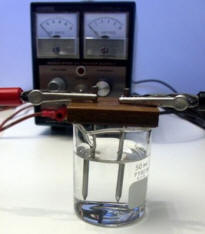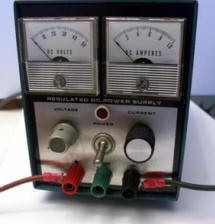 |
|
 |
 |
|
 |
 |
|
 |
 |
|
 |
Corrosion Current Experiment
| For this experiment you need a power supply. It could be a battery,
a single cell (1.5 volt) or one that can control the voltage or the current
it delivers. We have chosen the latest because we had one kicking around
in the Corrosion Doctors laboratory. The adjustable potential or current direct current (DC) power supply you see here delivers a continuously negative or positive potential depending if the electrode is connected respectively to the black or the red terminals. |
|
 |
The next step is to clean two steel nails with steel wool avoiding touching
the steel surface with greasy fingers and put them as illustrated in the
figure in a small vessel, a beaker in the present case, containing tap
water. As you can see, the left nail is connected to the red (+) terminal and the nail on the right to the black (-) terminal. What do you think happened when the power was turned on and the potential dial turned up? Please send your predictions to our and we will tell you how to find these pages ...and do not be surprised if we post your answers right here. |
Additional experiments of this kind:
Simple experiments to illustrate the theory:
Corrosion current, Galvanic coupling, Rust preventive testing
